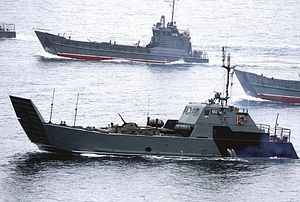Last week, a Russian Pacific Fleet ship detachment paid a visit to Myanmar in a little-noticed development. Though the interaction was just one activity within the broader bilateral relationship, it also highlighted the interactions underway between the two sides on the defense side.
Russian ship visits around Southeast Asia are nothing new: Russia has long had defense relationships with several Southeast Asian states, though some have been slower to develop than others. Yet it is also true that over the past few years, Moscow has stepped up its game in engaging ASEAN countries as part of a broader trend underway where Russia under Vladimir Putin – ambitious abroad and increasingly isolated from the West — has been looking to boost its presence in the Asia-Pacific.
Some Southeast Asian states have been more receptive to this than others as they too seek diversification in their ties, and, as they do so, they are no doubt aware of the limits and challenges inherent in Moscow’s foreign policy activism in the region (See: “Where are Russia-Philippines Defense Relations Under Duterte?”).
Myanmar is an interesting case in point in this regard. Russia-Myanmar defense relations have already long existed, with the more visible manifestations of this dimension of ties being Naypyidaw’s purchase of Russian military equipment and some training of Myanmar military personnel in Russian schools. Contrary to more sensational accounts of a binary choice for Myanmar between the United States and China, Naypyidaw has seen Russia as another option for it on the defense side, given both the restrictions created by decades of Western sanctions as well as the limits of relying on Beijing – whether it be for strategic reasons of overdependence or operational ones like the relative ineffectiveness of some Chinese equipment.
But Russia-Myanmar defense ties have also been on the uptick of late. Apart from the tempo on metrics like exchanges or visits, in one significant move last year, both defense establishments inked an agreement on military cooperation that established a legal framework for some of the collaboration that had either been ongoing or mulled. The scope of the pact was broad, covering military medicine, history, topography, culture, recreation of servicemen and family members, peacekeeping, search and rescue, information exchange on international security and counterterrorism, and elements of naval cooperation.
Though progress to this point appears much slower than the headlines might suggest, visits since then have still sought to translate some of this into tangible cooperation, with areas like education, exchanges, culture and technology. That progress is occurring within the broader context of adjustments in Myanmar’s foreign alignments in response to the ongoing Rohingya crisis as well as changing dynamics among major powers, chiefly the United States and China but also the others like India and Japan.
On December 7, the Admiral Panteleyev and Boris Butoma made an unofficial call to the port of Thilawa in Myanmar in an interaction that brought the relationship into focus. Myanmar was just the latest stop for the Russia Pacific Fleet ships, which, as noted above, have been making stops around the region, including in Brunei last month for the Golden Jubilee celebration of Sultan Hassanal Bolkiah’s accession to the throne – reported as the first visit in more than a quarter-century, a stop in the Philippines where there was a turnover of Russian weapons and Philippine officials, and a trip to Thailand for a set of ASEAN naval activities.
During the unofficial visit by the Russian vessels to Myanmar, several interactions were organized between the two sides. According to the Russian defense ministry, following a welcoming ceremony, representatives of the Myanmar Naval Command visited the Russian warship and Russian seamen paid a visit to the Commander of the Ayeyarwady Region and Chief of Naval Staff of Myanmar.
Other standard activities also took place during this time, including tours of the Admiral Panteleyev that were available to residents and guests of the city, football and volleyball competitions between seamen on both sides, and bus tours for the Pacific Fleet sailors around the historical sites of the city. And as expected, no details were publicly disclosed about what was discussed during the meetings. But the visit was nonetheless an important reminder of the activity underway on the defense side between the two countries.

































